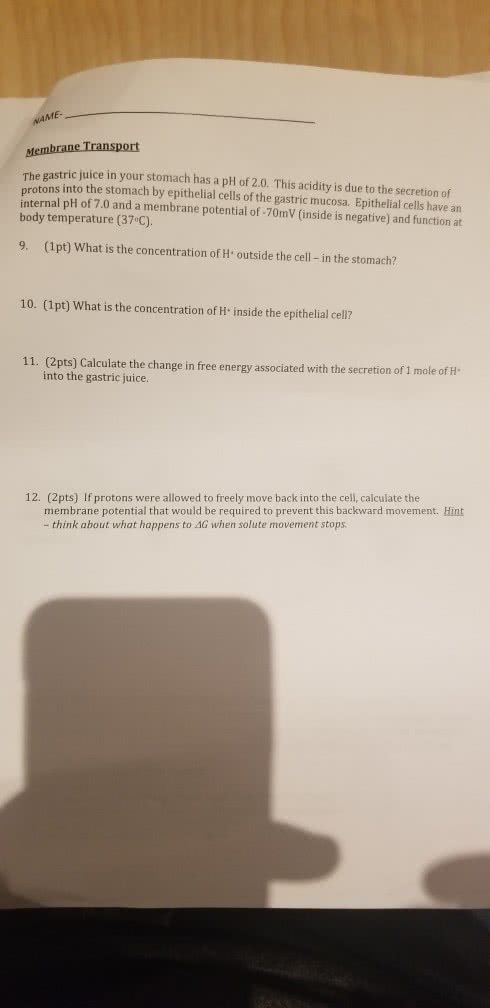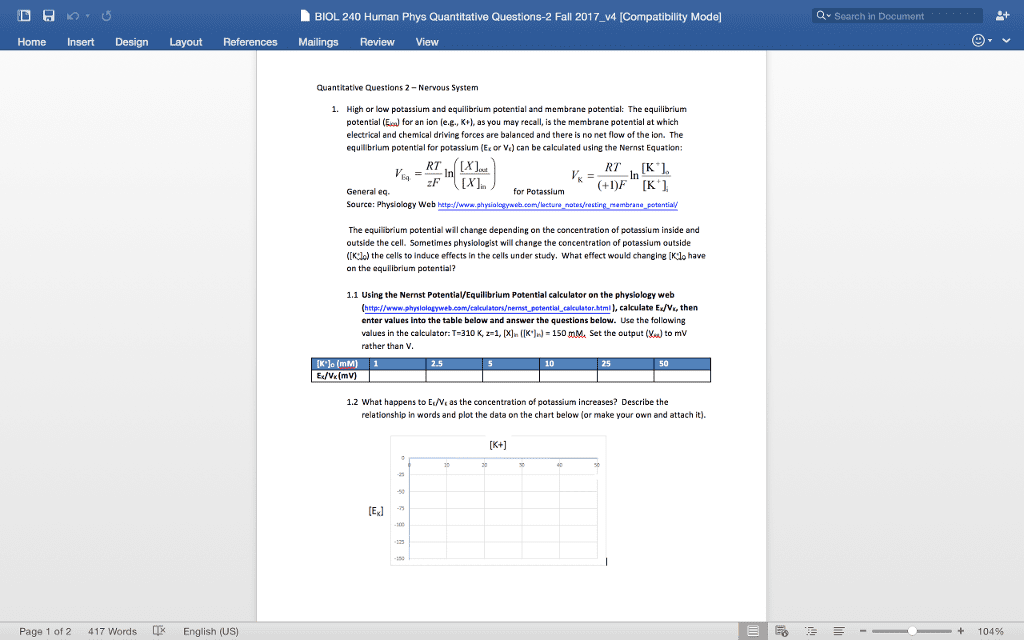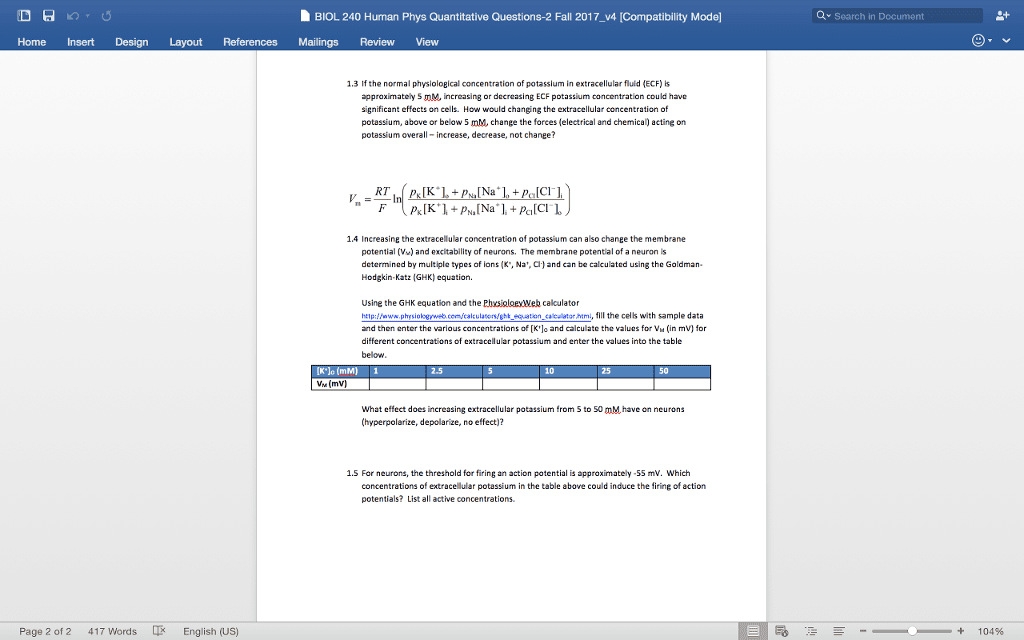CHE 350 Lecture Notes - Lecture 11: Atp-Binding Cassette Transporter, Maltodextrin, Periplasm

1 | Thermodynamics of Transport
A(out) ↔ A(in)
oGA = chemical potential
Chemical Potential Equation
If the concentration of A outside the membrane is greater than that of inside, ∆GA for the
transfer of A from out to in will be negative = spontaneous, so net flow will be inward
If the concentration of A is greater inside than outside, ∆GA is positive and an inward net
flow of A can occur only if an exergonic process, such as ATP hydrolysis, is coupled to it
to make the overall free energy change negative
Transmembrane movement of ions = charge differences across membrane, generating an
electrical potential difference
o∆ = (in) – (out)ѱ ѱ ѱ
o∆ = membrane potential ѱ
oPut this into the chemical potential equation, its not the electrochemical potential
Transport May Be Mediated or Nonmediated
Nonmediated transport = occurs through simple diffusion
oDriving force for the nonmediated flow of a substance through a medium is its
chemical potential gradient
oThe substance diffuses in the direction that eliminates its concentration gradient,
at a rate proportional to the magnitude/size of the gradient
oThe rate of diffusion of a substance also depends on its solubility in the
membrane’s nonpolar core
oNonpolar molecules (steroids, O2) readily diffuse through bio membranes by
nonmediated transport according to their concentration gradients across the
membranes
Mediated transport = occurs through the action of specific carrier proteins
oClassified into two categories depending on the thermodynamics of the system
1) passive-mediated transport (facilitated diffusion)
Specific molecule flows from high to low concentration
2) Active transport
find more resources at oneclass.com
find more resources at oneclass.com

A specific molecule is transported from low to high concentration
(against its concentration gradient)
As an endergonic process, it must be coupled to a sufficiently
exergonic process to make it favorable (∆G < 0)
2 | Passive-Mediated Transport
Substances that are too large or too polar to diffuse across lipid bilayers on their own can
cross membranes via proteins or other molecules that are variously called carriers,
permeases, channels, and transporters
oThese transporters operate under the same thermo principles but vary widely in
structure and mechanism, particularly their selectivity
A – Ionophores Carry Ions Across Membranes
Ionophores = organic molecules of diverse types, usually of bacterial origin, that increase
the permeability of membranes to ions
oOften exerts an antibiotic effect by discharging the vital ion concentration
gradients that cells actively maintain
Two types of ionophores:
o1) Carrier ionophores = increase the permeabilities of membranes to their selected
ion by binding it, diffusing thru the membrane, and releasing the ion on the other
side
For net transport to occur, the uncomplexed ionophore must then return to
the original side of the membrane ready to repeat the process
Carriers therefore share the common property that their ionic complexes
are soluble in nonpolar solvents
o2) Channel-forming ionophores = form transmembrane channels or pores through
which their selected ions can diffuse
Transportation of ions is rapid, but, since ionophores passively permit ions to diffuse
across a membrane in either direction, their effect can only be to equilibrate the
concentrations of their selected ions across the membrane
Ex: ionophore Valinomycin
oBinds K+
oCarrier ionophore
find more resources at oneclass.com
find more resources at oneclass.com

oPerfect shape for K+; space too big for Na+ or Li+ to bind, so has a 10k fold
greater binding affinity for K+ than Na+/Li+
B – Porins Contain Beta Barrels
Porins are beta barrel structures with a central aqueous channel
oRemember, porins = channel-forming proteins that let stuff in
The size of the channel and the residues that form its walls determine what types of
substances can pass through
Maltoporin is for maltodextrin (alpha (14) linked glucose oligosaccharide degradation
products of starch)
C – Ion Channels are Highly Selective
The movement of these ions is important for maintaining osmotic balance, for signal
transduction, and for neurotransmission
The Structure of the KcsA K+ Channel Explains Its Selectivity and Speed
K+ ions passively diffuse from the cytoplasm to the extracellular space thru
transmembrane proteins known as K+ Channels
A lot in a single organism but all of them are at least 10k fold more permeable to K+ than
Na+
Energetically strong interxns b/w K+ and the protein.. then why can its throughput rate be
so fast??
oOne of the best characterized K+ channels = KcsA
Homotetramer (all K+ channels are)
Four subunits, each containing 2 nearly antiparallel transmembrane helices
+ a short helix
Can travel through central pore hydrated, but the upper part of the pore
aka the selectivity filter, narrows to 3 A, forcing a transitioning K+ to shed
its waters of hydration
Lined with hydrophobic groups, act minimally with ions
Selectivity = Main chain O atoms lining selectivity filter form a stack of
rings that are appropriate dimensions for K+ but not Na+
find more resources at oneclass.com
find more resources at oneclass.com
Document Summary
A(out) a(in: ga = chemical potential. If the concentration of a outside the membrane is greater than that of inside, ga for the transfer of a from out to in will be negative = spontaneous, so net flow will be inward. Transmembrane movement of ions = charge differences across membrane, generating an electrical potential difference (in) (out: = membrane potential, put this into the chemical potential equation, its not the electrochemical potential. Mediated transport = occurs through the action of specific carrier proteins: classified into two categories depending on the thermodynamics of the system, passive-mediated transport (facilitated diffusion) Specific molecule flows from high to low concentration: active transport. A specific molecule is transported from low to high concentration (against its concentration gradient) As an endergonic process, it must be coupled to a sufficiently exergonic process to make it favorable ( g < 0)




